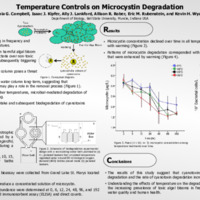Browse Exhibits (1 total)
Maia Campbell, Ally Lankford | Temperature Controls on Microcystin Degradation

Toxic cyanobacteria blooms are increasing in frequency and severity with rising surface-water temperatures. Warming generates a positive feedback on harmful algal bloom development by promoting toxic cyanobacteria over non-toxic strains, stimulating toxin synthesis, and subsequently triggering toxin release. The release of cyanotoxins into the water column poses a serious threat to water quality and human health. Yet, cyanotoxins rarely accumulate in the water column long-term, suggesting that biodegradation by heterotrophic bacteria may play a role in the removal process. Owing to increased metabolic rates at higher temperatures, microbial-mediated degradation of cyanotoxins may be influenced by warming. However, the effect of warming on the uptake and subsequent biodegradation of cyanotoxins has not yet been evaluated. In this study, we evaluated the ability for heterotrophic bacteria to degrade microcystin produced by a common cyanobacterium, Planktothrix agardhii, across a natural temperature gradient (from 5 to 20° C) during a laboratory incubation experiment. We measured microcystin concentration and bacterial abundance at 0, 6, 12, 24, 48, 96, and 192 hours. We found that microcystin concentration declined over time in all temperature treatments and degradation increased with warming. Patterns of microcystin degradation corresponded with increases in bacterial cell density over time that were enhanced by warming. Bacterial cell density increased most rapidly in the 20°C treatment resulting in the greater microcystin degradation than all other treatments. Degradation of microcystin was lowest in the 5°C treatment where the increase in bacterial cell density was the slowest. Bacterial density and microcystin degradation were similar between 10°C and 15°C treatments throughout the experiment and were consistently between 20°C and 5°C treatments. These results suggest that cyanotoxins can be reduced by microbial-mediated degradation and the rate of cyanotoxin degradation increases with water temperature.
Faculty Mentors: Dr. Allison R. Rober, Dr. Kevin H. Wyatt
Department of Biology
Undergraduate
